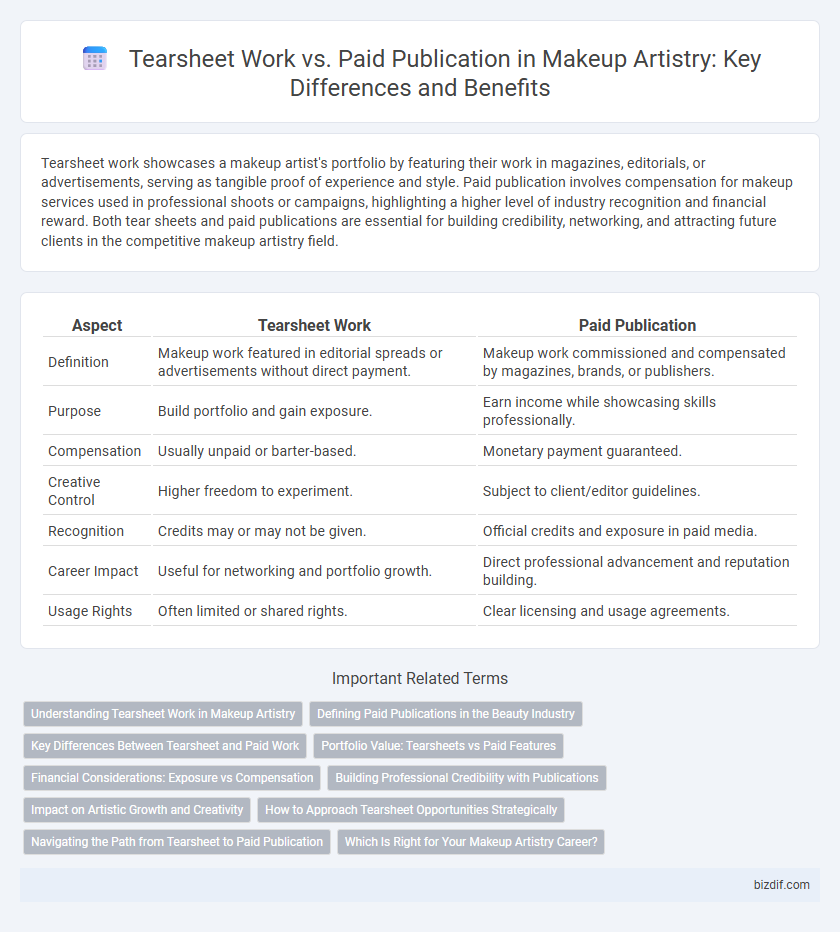Tearsheet work showcases a makeup artist's portfolio by featuring their work in magazines, editorials, or advertisements, serving as tangible proof of experience and style. Paid publication involves compensation for makeup services used in professional shoots or campaigns, highlighting a higher level of industry recognition and financial reward. Both tear sheets and paid publications are essential for building credibility, networking, and attracting future clients in the competitive makeup artistry field.
Table of Comparison
| Aspect | Tearsheet Work | Paid Publication |
|---|---|---|
| Definition | Makeup work featured in editorial spreads or advertisements without direct payment. | Makeup work commissioned and compensated by magazines, brands, or publishers. |
| Purpose | Build portfolio and gain exposure. | Earn income while showcasing skills professionally. |
| Compensation | Usually unpaid or barter-based. | Monetary payment guaranteed. |
| Creative Control | Higher freedom to experiment. | Subject to client/editor guidelines. |
| Recognition | Credits may or may not be given. | Official credits and exposure in paid media. |
| Career Impact | Useful for networking and portfolio growth. | Direct professional advancement and reputation building. |
| Usage Rights | Often limited or shared rights. | Clear licensing and usage agreements. |
Understanding Tearsheet Work in Makeup Artistry
Tearsheet work in makeup artistry refers to published images or features showcasing a makeup artist's work, often obtained from unpaid or collaborative projects that serve as portfolio building tools. These tearsheets highlight an artist's style and skill by appearing in fashion editorials, magazines, or online platforms, providing credible exposure without direct financial compensation. Understanding the value of tearsheets involves recognizing their role in attracting future paid publications, endorsements, and professional opportunities.
Defining Paid Publications in the Beauty Industry
Paid publications in the beauty industry refer to editorial content created specifically for commercial magazines, websites, or advertising platforms where makeup artistry is showcased with financial compensation. These publications often involve collaborations between makeup artists, photographers, and brands, ensuring high-quality visuals and exposure in targeted market segments. Unlike tearsheet work, which serves as portfolio evidence from unpaid or previous projects, paid publications provide both monetary benefits and professional recognition within the beauty sector.
Key Differences Between Tearsheet and Paid Work
Tearsheet work in makeup artistry showcases an artist's portfolio through unpaid, promotional features primarily in magazines or online media, highlighting creativity and style without direct financial compensation. Paid publications involve client-commissioned projects where makeup artists receive compensation for delivering specific looks tailored to commercial or editorial briefs. The key differences lie in payment structure, creative control, and professional exposure; tearsheet work emphasizes artistic visibility, while paid work centers on contractual obligations and income generation.
Portfolio Value: Tearsheets vs Paid Features
Tearsheet work showcases real-world editorial use of a makeup artist's skills, providing tangible proof of collaboration with recognized publications that boosts portfolio credibility. Paid publications, while often easier to control visually, may lack the industry validation that tearsheets offer, which can be essential for attracting high-profile clients or agencies. Incorporating both tearsheets and paid features ensures a balanced portfolio, demonstrating versatility and professional recognition in makeup artistry.
Financial Considerations: Exposure vs Compensation
Tearsheet work in makeup artistry primarily offers exposure without direct financial compensation, serving as a portfolio builder for emerging artists. Paid publications provide makeup artists with monetary compensation, often reflecting their professional experience and the project's scope. Balancing tearsheet opportunities with paid jobs is essential for sustained financial growth and career advancement in the beauty industry.
Building Professional Credibility with Publications
Tearsheet work showcases an artist's published pieces, serving as tangible proof of experience and skill to potential clients and agencies. Paid publications elevate professional credibility by demonstrating investment in one's brand and access to higher-profile platforms, often reaching a wider industry audience. Both forms contribute to a makeup artist's portfolio, but paid placements tend to offer stronger validation and ongoing recognition in competitive markets.
Impact on Artistic Growth and Creativity
Tearsheet work offers makeup artists tangible proof of their skills in real-world settings, fostering artistic growth through diverse project experiences. Paid publications provide broader exposure and validation, often pushing artists to refine their creativity to meet professional standards and audience expectations. Both avenues contribute uniquely to a makeup artist's portfolio development and industry reputation.
How to Approach Tearsheet Opportunities Strategically
Tearsheet work in makeup artistry involves showcasing your skills through unpaid collaborations or personal projects, serving as a portfolio builder to attract paid publication opportunities. Strategically approach tearsheet opportunities by targeting influential photographers, stylists, and brands that align with your aesthetic and professional goals, ensuring each collaboration enhances your visibility and credibility in high-value markets. Prioritize quality over quantity, documenting every project meticulously to leverage these sheets as powerful testimonials when negotiating paid gigs and agency representation.
Navigating the Path from Tearsheet to Paid Publication
Tearsheet work functions as a vital portfolio tool for makeup artists, showcasing their skills to potential clients and industry professionals. Transitioning from tearsheet exposure to paid publication requires strategic networking, building strong relationships with editors and photographers, and demonstrating versatility across different makeup styles. Consistent quality work and professional reliability increase the likelihood of securing paid editorial assignments and advancing a makeup artist's career.
Which Is Right for Your Makeup Artistry Career?
Tearsheet work showcases your makeup artistry by featuring your work in editorials or client projects without guaranteed payment, serving as powerful portfolio-building tools to attract future opportunities. Paid publications provide financial compensation and often broader exposure, enhancing professional credibility and creating revenue streams. Evaluating your career goals, financial needs, and desired visibility helps determine if prioritizing tear sheets or paid publications aligns better with your makeup artistry growth strategy.
Tearsheet work vs Paid publication Infographic

 bizdif.com
bizdif.com